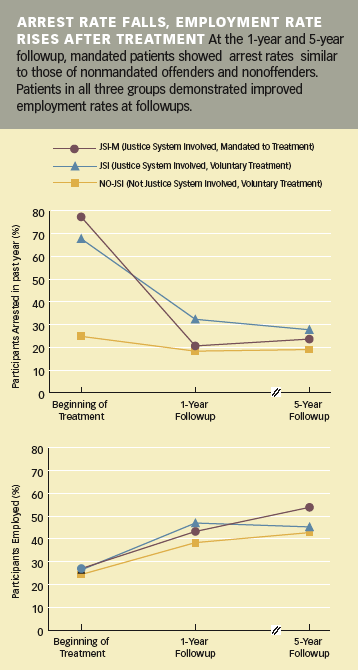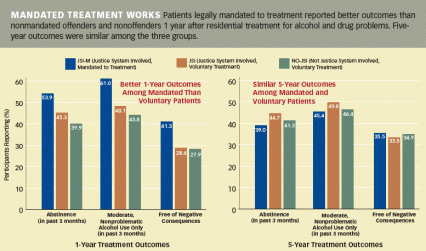A group of men who completed court-ordered treatment for alcohol and drug problems reported lower intrinsic motivation at the beginning of treatment, but, 5 years later, reported the same rates of abstinence, employment, and rearrest as peers who sought help on their own. The findings from a NIDA- and Department of Veterans Affairs (VA) Health Services Research and Development Service-supported analysis of data on treatment outcomes affirm the results of shorter term studies that have shown similar therapeutic outcomes for voluntary and legally mandated patients. The new study also included an important, but largely unstudied, comparison group: people who had been in court, but were not mandated to enter treatment.
"Once in a therapeutic environment, mandated patients seem to reflect on their situation and accept the need for treatment," says Dr. John Kelly, lead investigator of the study, conducted at the VA Palo Alto Healthcare System and Stanford University School of Medicine. "Our findings suggest that people can learn from the 'teachable moment' offered by a judicial mandate, even though the initial motivation for treatment is external. Judicial mandates may provide an opportunity for offenders to gain access to and benefit from needed treatment."
Drs. Kelly, Rudolf Moos, and John Finney analyzed data, gathered by Drs. Moos and Finney and Dr. Paige Ouimette, on 2,095 men who were treated for alcohol and drug problems in 15 VA programs and followed for 5 years. About half the men (54 percent) were addicted to drugs; 80 percent were dependent on alcohol. Most (82 percent) had no criminal justice system involvement and entered treatment voluntarily (No-JSI); 7 percent were on probation or parole and were required to participate in treatment by order of a court or criminal justice official (JSI-M); 11 percent had been before a court, but not mandated to treatment (JSI). About half (49 percent) of the participants were African-American; 45 percent were White; and the remaining 6 percent were Hispanic, Native American, or Asian. Most (74 percent) were unemployed when they started treatment.

The men completed 21 or 28 days of residential treatment, which took one of three therapeutic approaches: group psychotherapy and individual activities based on the 12-step approach, cognitive-behavioral therapy, or a mix of both. When they completed treatment, the men were urged to participate in outpatient programs and self-help activities.
At the beginning of treatment, each man completed a questionnaire that assessed characteristics considered important to recovery: motivation, self-efficacy, coping skills, 12-step participation, psychiatric symptoms, history of negative consequences of alcohol and drug problems, number of previous treatment episodes, and whether they considered themselves to be addicted. They also reported any prior year arrests and any judicial mandate for treatment. At the end of the treatment program, participants repeated the assessment and reported their perceptions of the therapeutic experience. Most also received a self-administered assessment in the mail at the 1- and 5-year follow up points, with the rest contacted by telephone or in person. Research assistants telephoned patients when necessary to complete or clarify information.
In the initial assessment, men in the JSI-M group reported experiencing fewer negative consequences of alcohol and drug consumption, fewer symptoms of depression and anxiety, and less desire to abstain than No-JSI or JSI participants. Fewer mandated (45 percent) than voluntary patients (58 percent) met the standard clinical criteria for drug addiction. Voluntary patients more frequently recognized their addictions, connected them to other problems, and reported a readiness to change.
Rearrest Rates Fall, Remain Low
At the end of treatment, all three groups of patients demonstrated enhanced coping skills and expressed more confidence that they could resist alcohol or drugs in high-risk situations. Symptoms of psychological distress improved for participants in all groups. At the 1-year followup, larger proportions of JSI-M participants reported abstinence, successful moderation in their use of alcohol, and freedom from drug-related consequences (for example, missing work or fighting with a family member because of drugs) than JSI and No-JSI participants. Arrest rates for the two JSI groups fell dramatically after treatment. Mandated patients showed arrest rates similar to those of their No-JSI peers (about 20 percent) and lower than those of their JSI peers (32 percent) at the 1-year followup. Five years after treatment, most outcomes among the three groups did not differ.
The investigators believe that, in addition to the other positive effects of treatment, mandated patients may acquire motivation to change. "The high level of camaraderie in VA residential treatment, where these individuals interacted with self-motivated peers, may have contributed to a shift in attitude," says Dr. Kelly.
The implications of Dr. Kelly's findings go beyond the criminal justice population, says Dr. Beverly Pringle, formerly of NIDA's Division of Epidemiology, Services and Prevention Research. "The idea that patients must want to change seems to permeate current practice, but the drug abuse treatment field may need to reexamine its definition of motivation," she says. Clinical measures of motivation mostly indicate intrinsic drive to change, but extrinsic motivators as well as rewards can increase treatment entry and improve long-term outcomes.
Source
- Kelly, J.F.; Finney, J.W.; and Moos, R. Substance use disorder patients who are mandated to treatment: Characteristics, treatment process, and 1- and 5-year outcomes. Journal of Substance Abuse Treatment 28(3):213-223, 2005. [Abstract]

